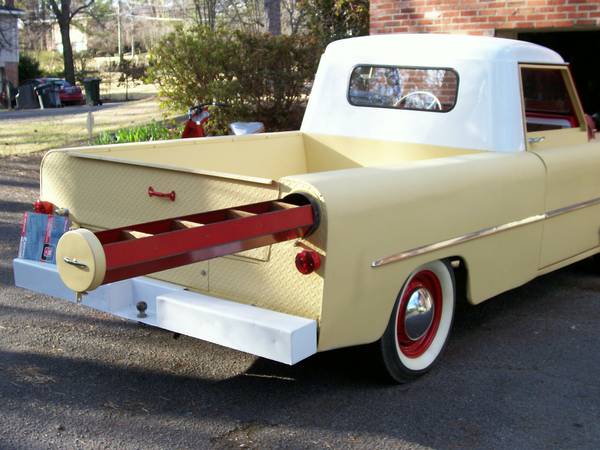The Powell Sport Wagon
While most vehicles end their lives in a junkyard, every one of the thousand or so Powell Sport Wagons built from 1955 to 1957 started out there. Beneath each modern looking steel and fiberglass truck body are the refurbished bones and innards of a 15-year old Plymouth plucked from the scrapheap. This noble act of recycling resulted in the first of a whole new category of vehicle that we now call the Crossover SUV.
Junked ‘41 Plymouth
The Powell Sport Wagon was the brainchild of Hayward and Channing Powell, two Southern California brothers who became small time industrialists producing radios in the 1920s. As the decade aged, competition from bigger names like RCA and Crosley squeezed their profits. Undaunted, the Powells shifted their attention to making motor scooters. Business was fairly robust right up until World War II. But when post-war manufacturing resumed in the late 1940s, new challenges from the cheaper Cushman and the more refined Vespas scooters forced the brothers to shift gears again, and rethink their place in the personal transportation business. Pehaps four wheels would be more profitable than two.
The search for opportunity had them take a look at their sportsman lifestyle. The “sportsmen’s car,” as they called it would be targeted toward guys like themselves, who wanted the utility of a Jeep but were willing to trade some off-road capability for a more comfortable driving experience.
(www.Morfar.info)
The Powell Sport Wagon was not only appropriately named, but It could be argued that it was also the very first Crossover SUV. The design parameters laid down by the Powells when they started in 1953 were indeed similar to today’s Toyota RAV-4 or Honda CR-V. It would drive with the ease and comfort of a car, but have the ruggedness and utility of a truck. Where it diverged from our modern little luxury boxes on wheels, ubiquitous in every supermarket parking lot and elementary school pickup line, was that the Powell SUV was meant to be cheap to build, and to buy. This last requirement was achieved by employing the time-tested practice of turning one man’s junk into another’s gold.
Powell Broshure (circa 1955)
The Powells tested prototypes that used the components of several best sellers of the past. They eventually settled on the chassis and drivetrain of the 1940-41 Plymouth, a car known for its robust engineering. These parts were long out of production but lay in abundance in scrap form throughout the salvage yards of Southern California. A decent chassis could be had for just $45, with an L-head engine and 3-speed gearbox for not much more. Powell representatives would scout and collect the pieces, and send then off to be refurbished and rebuilt by an outside supplier in Glendale. The reborn and now gleaming former Mopar bits were then shipped to the Powell factory down in Compton, where they would be introduced to truly new bodies and interiors.
Those bodies were made of stamped steel and had no compound curves, keeping tooling costs to a minimum. Front end clips were made of fiberglass and molded by a local boat yard. Bumpers and tailgates were initially made of oak wood, switching to steel in 1956 for safety reasons. To reduce complexity, side windows were of the sliding glass variety. Seats were made of simple vinyl stretched over foam rubber pads, rather than costlier springs.
The one “luxury” feature on a Powell was an optional storage tube that slid out from a compartment between the truck bed’s inner and outer sheet metal. It was meant to safely store long thin items of the sportsman’s trade, like hunting rifles or fishing poles.
Employing used components indeed kept Powell’s costs down. A standard Sport Wagon pickup truck cost just $1095. Deluxe versions, with two-tone paint jobs, and chrome bits scraped off old Fords (from the same scrapyards that the old Plymouth bits came from) cost $1195. A Sport Wagon station wagon was added to the lineup in 1956.
Despite pioneering a category that today accounts for 6 million annual sales, the Powell brothers shut down their operations in 1957. This was not because of the financial woes to which most other post-war automotive start-ups had succumbed. Powell Sport Wagons were cheap to build and sold at a reasonable profit. But a business model that includes a bunch of local junkyards as an integral part of its supply chain meant that Powell Motors was not designed for the long haul. They simply ran out of used parts.
In more its than two years of production, Powell Motor Company made nearly a thousand pickup trucks and over 150 station wagons. Most were sold in California, and almost none east of the Rockies. The Powell Registry lists 130 Sport Wagons still in existence.
Copyright@2018 by Mal Pearson
Sources and Further Reading:
www.Throwinwrenches.blogspot.com Powell, Plymouth and Pull-out Drawers, November 23, 2014
www.handeyesupply.comPowell Sport Wagon, the Discount SUV, July 17, 2015
www.Bangshift.com1956 Powell Pickup, by Brian Lohnes, April 15, 2014
www.Allpar.comCarlike SUV Ahead of Its Time, by Jim Benjaminson, no date
The Powell Registry http://clubs.hemmings.com/powellregistry/







